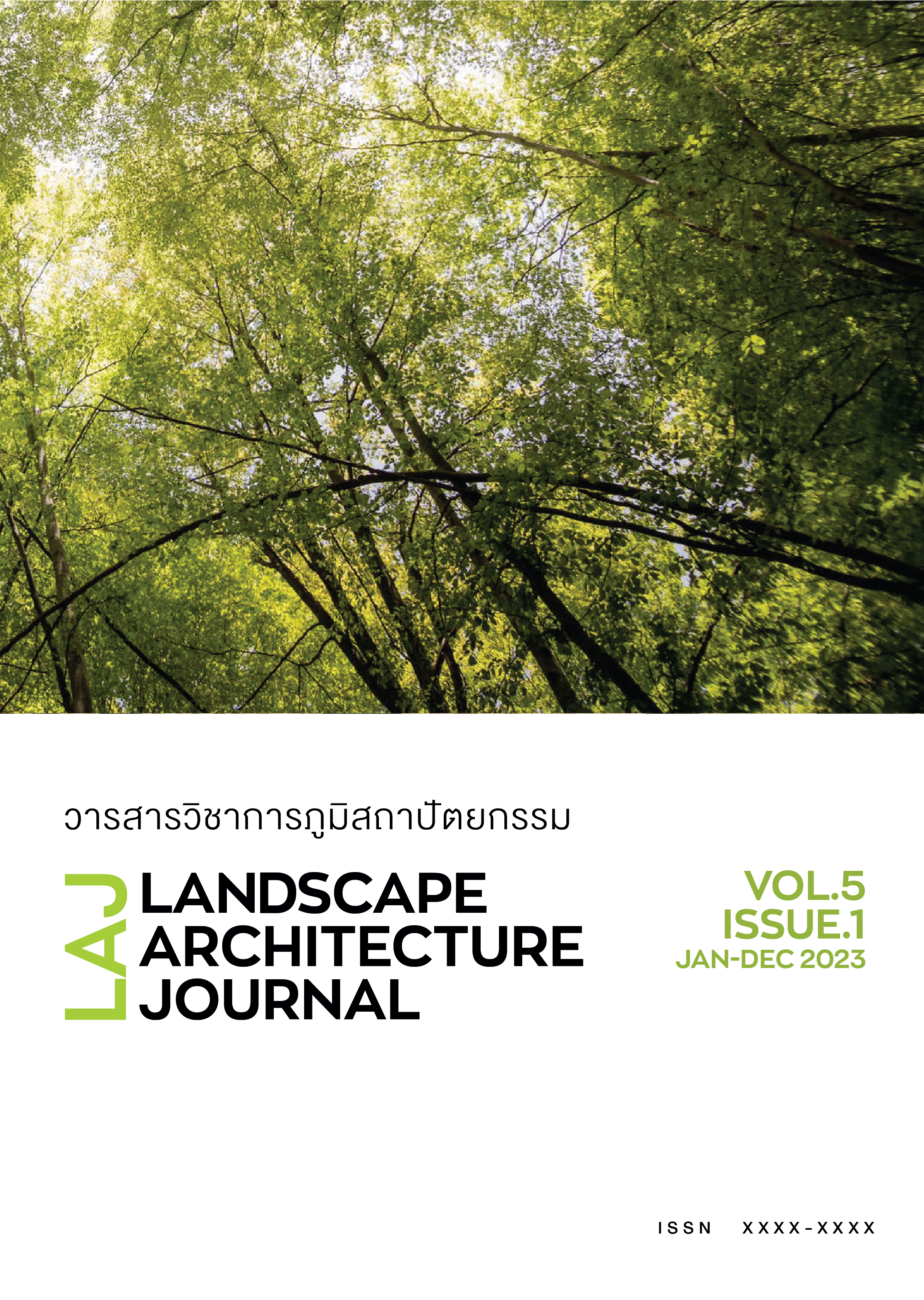A Study of the Relationship Between Soil Cover Characteristics and Water Quality in the Area of Pong Yaeng Nai Village, Mae Rim District, Chiang Mai
Main Article Content
Abstract
Pong Yaeng Nai Village has been continuously expanding in tourism and agriculture. Some portions of the forested areas have been converted into farmland, mainly for single-crop cultivation. The expension has resulted in a loss of biodiversity and directly impacted on the quantity and quality of water in this area. Furthermore, the village’s terrain comprises limestone hills and steep slopes, leading to the mixing of limestone and heavy metals in local water sources. Consequently, water quality in the area is closely tied to the land cover characteristics in the upstream and watershed areas. Therefore, the objective of this research is to categorize land cover in various parts of the region and investigate the relationship between land cover characteristics and water quality. The ultimate goal is to identify ways to improve the area through integrated approaches, considering landscape architecture and water quality enhancement.
Article Details

This work is licensed under a Creative Commons Attribution-NonCommercial-NoDerivatives 4.0 International License.
References
กรมควบคุมมลพิษ กระทรวงทรัพยากรธรรมชาติและสิ่งแวดล้อม. (2553). วิธีปฏิบัติสำหรับการเก็บตัวอย่างน้ำจากแหล่งน้ำ. เข้าถึงได้จาก https://www.pcd.go.th/publication/4209
กรมพัฒนาที่ดิน. (2563). แผนที่เส้นชั้นความสูงบริเวณบ้านโป่งแยงใน. กรุงเทพฯ: กรมพัฒนาที่ดิน.
กรมอนามัย. (2563). ประกาศกรมอนามัย เรื่อง เกณฑ์คุณภาพน้ำประปาดื่มได้ กรมอนามัย. เข้าถึงได้จาก https://foodsan.anamai.moph.go.th/th/water-quality/204437
ประกอบ วิโรจนกูฏ. (2539). อุทกวิทยาของน้ำผิวดิน. ขอนแก่น: โรงพิมพ์คลังนานาวิทยา.
พิรานันท์ จันทาพูน. (2558). ผลกระทบด้านสังคมและวัฒนธรรมจากการท่องเที่ยวโดยชุมชน ตามการรรับรู้ของครัวเรือนบ้านแม่สาใหม่ ตำบลโป่งแยง อำเภอแม่ริม จังหวัดเชียงใหม่. มหาวิทยาลัยแม่โจ้.
มนตรี ผลสินธ์ และ เพ็ญรดี จันทร์ภิวัฒน์. (2564). แนวโน้มการเปลี่ยนแปลงคุณภาพน้ำกับความมั่นคงด้านสิ่งแวดล้อมในพื้นที่ระเบียงเศรษฐกิจพิเศษภาคตะวันออก. วารสารสิ่งแวดล้อม, 25(2). เข้าถึงได้จาก http://www.ej.eric.chula.ac.th/content/6138/309
ยุพเรศ สิทธิพงษ์ และยุทธนา ทองท้วม. (2562). การลดผลกระทบของน้ำท่าผิวดินจากการเปลี่ยนแปลงสิ่งปกคลุมผิวดินด้วยการบูรณาการองค์ความรู้ทางโครงสร้างพื้นฐานภูมินิเวศวัฒนธรรมล้านนา และทางภูมิสถาปัตยกรรม กรณีศึกษาคณะสถาปัตยกรรมศาสตร์ มหาวิทยาลัยเชียงใหม่ เอกสารนำเสนอในที่ประชุม. การประชุมวิชาการสร้างสรรค์ระดับชาติและ การสัมมนาระดับบัณฑิตศึกษา “ภูมิปัญญาพื้นถิ่นสร้างสรรค์” วันที่ 6-7 มิถุนายน 2562 ณ คณะสถาปัตยกรรมศาสตร์ มหาวิทยาลัยเชียงใหม่.
วิวัฒน์ อ่อนนาคคล้ำ. (2563). ผลร่วมของการเติมคลอรีนแบบขั้นต้นและสารตกตะกอนต่อการกําจัดความขุ่นของกระบวนการตกตะกอนในระบบผลิตนํ้าประปาโดยถังตกตะกอนชนิดชั้นตะกอน. วารสารวิชาการวิศวกรรมศาสตร์ม.อบ., 13(2). เข้าถึงได้จาก https://ph02.tci-thaijo.org/index.php/eng_ubu/article/view/242804/164677
สุพัตรา ศรีสันต์, ณัฐวิญญ์ ชวเลิศพรศิยา, พิสุทธิ์ เพียรมนกุล. (2561). การพัฒนากระบวนการร่วมทางกายภาพ-เคมีสําหรับการกําจัดความกระด้างและซิลิกาในน้ําบาดาล. วารสารวิศวกรรมสิ่งแวดล้อมไทย, 32(3). เข้าถึงได้จาก https://so05.tci-thaijo.org/index.php/teej/article/view/198914/138677
ส่วนสนับสนุนโครงการอันเนื่องมาจากพระราชดำริ. (2563). เทคนิคและวิธีการเก็บตัวอย่างน้ำ (Sampling Technique / Sampling Procedure). เข้าถึงได้จาก http://www.dgr.go.th/skr/th/newsAll/243/3155
Cadenasso, M. L., Pickett, S. T. A., & Schwarz, K. (2007). Spatial Heterogeneity in Urban Ecosystems: Reconceptualizing Land Cover and a Framework for Classification. Ecological Society of America. https://esajournals.onlinelibrary.wiley.com/doi/full/10.1890/1540-9295%282007%295%5B80%3ASHIUER%5D2.0.CO%3B2
City of Sydney. (2017). Environmental Action 2016-2021: Strategy and action plan. City of Sydney. https://www.cityofsydney.nsw.gov.au/strategies-action-plans/environmental-action-2016-2021-strategy-action-plan
Global Solution Networks. (2013). Global Water Partnership: Lighthouse Case Study. Global Solution Networks. http://gsnetworks.org/wp-content/uploads/2013/12/CS-Global-Water-Partnership.pdf
Global Water Partnership. (2019). Mobilising for a Water Secure World: Strategy 2020-2025. Global Water Partnership. https://gwp.org/globalassets/global/about-gwp/strategic-documents/gwp-strategy-2020-2025.pdf
Google Map. (2021). Aerial photograph of Ban Pong Yaeng Nai.
Kibria, G. (2015). World rivers in crisis: water quality and water dependent biodiversity are at risk- Threats of pollution, climate change & dam’s development. Research Gate, November, 12. https://doi.org/10.13140/RG.2.1.1791.5365/2
Natural Resources Conservation Service. (1986). Urban Hydrology for Small Watersheds TR-55. The U.S. Department of Agriculture. https://nationalstormwater.com/urban-hydrology-for-small-watersheds-tr-55/.
Natural Resources Conservation Service. (2009). Small Watershed Hydrology WinTR–55 User Guide. The U.S. Department of Agriculture. https://irrigationtoolbox.com/NEH/UserGuides/WinTR-55_01-09.pdf.
UN-Water. (2019). Climate Change and Water: UN-Water Policy Brief. UN-Water.
United Nations Department of Economic and Social Affairs. (2015). Sustainable Development: the 17 goals. Sustainable Development. https://sdgs.un.org/goals

